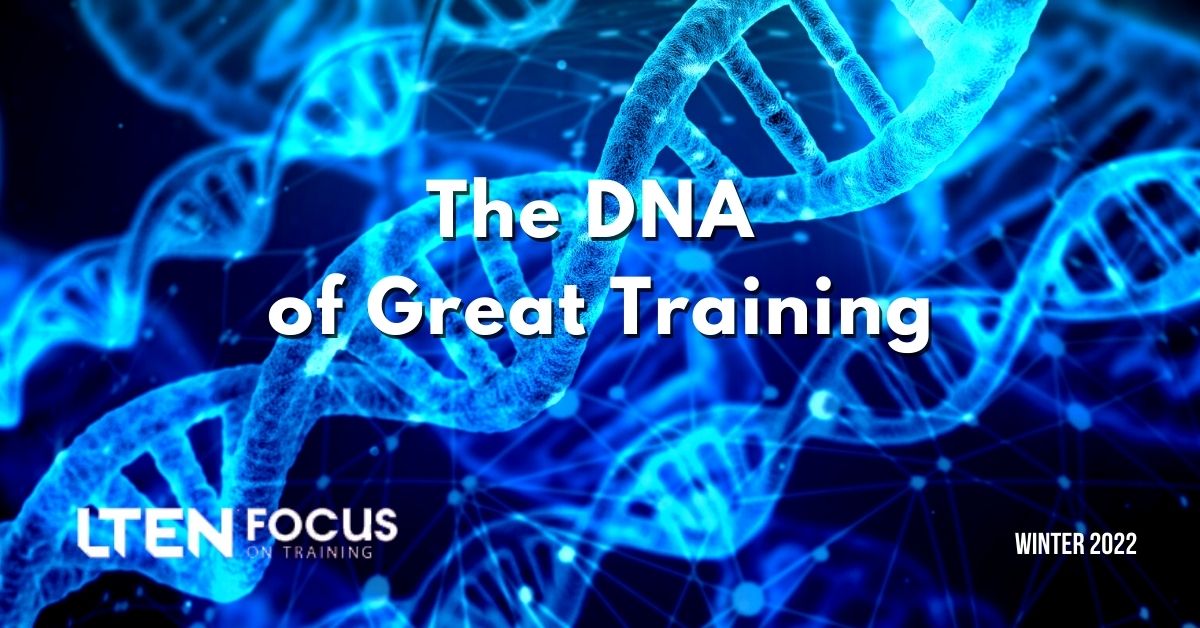
The DNA of Great Training
Feature Story – By Bob Szostak, PMP, CPTM
Agile companies share a common thread that leads to lasting change.
 The LTEN community has just wrapped up another successful awards season with many deserving nominees, winners and sponsors who helped move the learning profession forward during some unique and challenging circumstances. To put it into context, if the past year were an Olympic high dive, it would have a degree of difficulty of at least 4.5.
The LTEN community has just wrapped up another successful awards season with many deserving nominees, winners and sponsors who helped move the learning profession forward during some unique and challenging circumstances. To put it into context, if the past year were an Olympic high dive, it would have a degree of difficulty of at least 4.5.
Yet we persevered, performed and even prospered.
As we look back across the past year in the broader learning market, we see the work to turn quick improvisations into lasting change. We can see a common thread for the organizations that were not only best prepared to respond with agility to what was needed, but are also best positioned to capitalize on new work dynamics:
They have great training DNA.
What Is Training DNA?
In the simplified version of a scientific explanation, we know (or rather Wikipedia says) that DNA is:
- The structure that contains the genetic information that guides the development and function of an organism.
- The underlying building block that allows information to be passed down between generations.
So, what then is training DNA? If we looked at training DNA in the same vein, we would say that training DNA is:
- The foundation that contains the performance information that guides the development and function of contributors toward organizational performance.
- The underlying building block for knowledge transfer, which allows that information to be passed between contributors.
 Think about this last part specifically as it relates to our evolving learning landscape. Knowledge retention and knowledge transfer were hot items before the pandemic due to the rolling waves of retirees exiting the workforce.
Think about this last part specifically as it relates to our evolving learning landscape. Knowledge retention and knowledge transfer were hot items before the pandemic due to the rolling waves of retirees exiting the workforce.
It has only become more critical as many of the programs, informal learning opportunities and mentoring have been impacted. In fact, according to Deloitte’s Global 2020 Human Capital Trends study, 75% of organizations say “creating and preserving knowledge across evolving workforces is important or very important for their success over the next 12-18 months.”
Building Training DNA
So how does an organization go about building strong training DNA? The answer is in the acronym, Don’t Neglect Analysis.
Analysis tends to be a tired word in the increasingly techno- and learner-centric world of learning. Beyond being the first phase of the ADDIE model (which in and of itself has also become somewhat unfairly maligned in recent years), we sometimes associate analysis with creating a complex set of requirements that organizations do not have the time or money to address in their entirety.
However, even when we are creating elements of learning – be it micro-learning, job aids, point of use support or so on – each individual element supports a broader goal and a broader system. Without analysis, there can be no proper understanding of that system or the inter-relatedness of learning content. Without this understanding, this foundation has the potential for gaps, redundancies, sub-optimization and waste, which creates risk for compliance-based organizations.
On the delivery side of things, where learning touches the learner, we have intelligent and adaptive platforms, self-directed learning journeys and social platforms. These engage, personalize and generally meet the learner in a manner and modality in which they are native and proficient.
Analysis, by contrast, seems quite archaic in its methods and modalities. And while we’ve seen great strides in the use of artificial intelligence, natural language processing and prescriptive software to aid in these efforts, it is still at its core a very human and interactive process. Which, when we are dealing with determining objectives and outcomes for human performance, is perhaps as it should be.
Great Learning Results
As learning professionals, we understand that a solid analysis is the foundation for everything that follows, from a learning and measurement standpoint as well as creating a foundation for managing change. Without analysis, it would be challenging to show ROI or even behavioral or business change; it is the heart of the training system.
There are solid, proven virtual and premise-based processes for extracting, documenting, categorizing, organizing and sharing the base information required for a solid analysis. That can be done in a matter of days to weeks, depending on the scope.
These processes create tangible outcomes, roadmaps and manipulable data to allow organizations to prioritize learning interventions, to understand relationships between objectives, roles and departments, and to identify opportunities for synergy as well as eliminating waste. In this manner, analysis output is a value-added deliverable in and of itself, not just a means to an end.
We’ve come a long way in terms of proving business value and earning a seat at the table, even if that seat is increasingly more of a square on the Zoom or Teams conference. Focusing on our training DNA will help ensure we maintain it.
Bob Szostak, PMP, CPTM is a client solutions manager for Raytheon Professional
Services. Email Bob at rszostak@raytheon.com.








